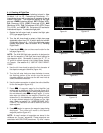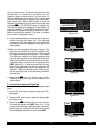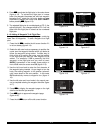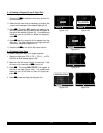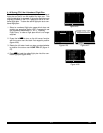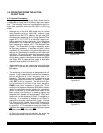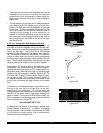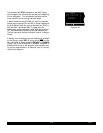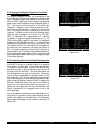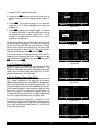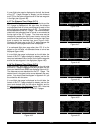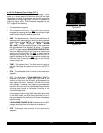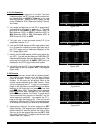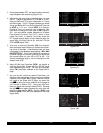
4-10
Rev 1
4.2.3 Viewing The Waypoint Pages For The Active
Flight Plan Waypoints
The waypoint pages(s) for each of the waypoints in the
active flight plan may be easily displayed by selecting the
Active Waypoint page type (ACT) on the right side.
When the ACT page type is first selected, the waypoint
page for the active waypoint will be displayed (figure 4-
37). The location of the waypoint in the flight plan
(waypoint 1, waypoint 2, etc.) is annunciated with a num-
ber to the left of the identifier. In addition, an arrow to the
left of the waypoint number designates the active
waypoint. The letter to the far right of the identifier desig-
nates the type of waypoint: A= airport, V= VOR, N=
NDB, I= intersection, S= supplemental or T= terminal
(for details on terminal waypoints see section 6.1.2). For
VORs having DME capability, the letter D is displayed
between the VOR identifier and the V. To view the other
waypoints in the flight plan, pull the right inner knob to the
“out” position and turn it to view each of the waypoints in
the order they are contained in the flight plan (figure 4-
38). For airport waypoints, the right inner knob may be
pushed back to the “in” position and rotated to display any
of the eight airport pages (figure 4-39). Pulling the knob
back out will allow further scanning of the waypoint pages
in the active flight plan.
4.2.4 Combining Direct To And Flight Plan Operation
It is very common when using flight plan operation to use
the Direct To function to proceed directly to a waypoint
which exists in the flight plan. For example, after takeoff it
is common to receive radar vectors in the terminal area
and then be given a clearance direct to the first point in
the flight plan that was filed. The KLN 90B makes this
kind of operation very easy to accomplish. Whenever
you do a Direct To operation to a waypoint which is in the
active flight Plan (FPL 0), the system will provide naviga-
tion to the waypoint and then automatically resume navi-
gation along the flight plan when the Direct To waypoint is
reached. Waypoints which exist prior to the Direct To
waypoint in the active flight plan are bypassed. Of
course, the active flight plan will never be resumed if the
Direct To operation is to a waypoint which is not in the
active flight plan.
Any of the several methods previously described for initi-
ating Direct To operation may be used, although the one
below is the easiest for this application. The procedure
below takes advantage of rule number 1 described in
section 3.8.
; 1:KNEW |= 2 GPT D V
< 2:GPT |GULFPORT
3:SJI | L
4:CEW |109.00 2^E
5:MAI |N 30^24.40'
8:KPIE |W 89^04.60'
FPL 0|enr-leg |ACT
Figure 4-37
; 1:KNEW | 8 KPIE A
< 2:GPT |ST PETES-
3:SJI |CLERWTR
4:CEW |CL B
5:MAI |N 27^54.63'
8:KPIE |W 82^41.26'
FPL 0 enr-leg ACT 1
Figure 4-38
; 1:KNEW | 8 KPIE A
< 2:GPT |
3:SJI |17L/35R L
4:CEW | 8500' HRD
5:MAI |04 /22 L
8:KPIE | 5500' HRD
FPL 0 enr-leg ACT[3
Figure 4-39



